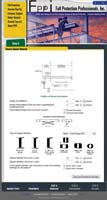Computer Applications
- By Jerry Laws
- Apr 01, 2009
 Would an online engineering analysis of fall protection anchor points really work? Who needs it? I asked those questions before seeing a demo of the Anchor Point Evaluation Program from Fall Protection Professionals, Inc.'s Jeffrey B. Reep, P.E., the Green Bay, Wis., company's senior structural engineer and developer of the program. What he demonstrated was the initial release, which evaluates the steel supports of fixed or mobile anchoring systems. Timber and concrete add-on modules are scheduled to be released later this year, Reep said.
Would an online engineering analysis of fall protection anchor points really work? Who needs it? I asked those questions before seeing a demo of the Anchor Point Evaluation Program from Fall Protection Professionals, Inc.'s Jeffrey B. Reep, P.E., the Green Bay, Wis., company's senior structural engineer and developer of the program. What he demonstrated was the initial release, which evaluates the steel supports of fixed or mobile anchoring systems. Timber and concrete add-on modules are scheduled to be released later this year, Reep said.
A facilities manager whose company is using the steel module and who has seen the program evolve in response to user feedback said Anchor Point will be useful for safety managers who oversee fall protection programs and need outside help to ensure proposed anchor points are acceptable. Not everybody has a support staff, as this manager pointed out.
Reep said the product was developed in response to 1) a shortage of qualified persons who can evaluate anchor points and 2) too many fall fatalities in U.S. workplaces. The program costs $1,800 per seat license; the end user must be a competent or qualified person and must take an extensive, 15-chapter tutorial and earn a score of 80 or better to pass its 40-question test before he or she receives a password to use the program. Reep said bringing a qualified expert into a plant to evaluate anchor points would cost $1,500 to $2,000, making the program's cost reasonable.Using it, customers will have the most up-to-date information available without having to pay for seminars or conduct product research, according to FPPi.
Anchor Point creates a schematic of an anchor point based on information entered by the user. Evaluations and approvals are based on the most current versions of the ANSI Z359 fall protection standards and OSHA fall protection standards.Anchor Point evaluates the entered data and responds with a green, yellow, or red signal, with the latter meaning "don't use this anchor point."
"The program's designed not to give up on an anchor point" and will suggest alternatives if an anchor point doesn't pass, said Reep.
Complete, Accurate Information Paramount
The program's certification process includes checking to ensure there is sufficient clearance for a worker's fall protection equipment to work properly and that the proposed support system and connecting hardware are satisfactory. For example, Reep said, the program will alert a user that a self-retracting lifeline can't be anchored to a point below the wearer's feet or at an angle greater than 30 degrees from the anchor point to the spot where the wearer is standing. That's because the fall force in those situations would strip the SRL's gears, and the worker would fall to the ground, he said.
The program produces a printable certificate for an anchor point that does pass. The customer prints and files the certificate, and FPPi stores the results. The company says it will maintain a history of each user's anchor points so they can be promptly retrieved when needed and will permanently archive them, in case the user's copies are lost or destroyed.
Users are buying a license to use the program, not buying the program itself.While they have access to the FPPi Help Desk manned by qualified persons, this is not a free service. (Several hours of access to the Help Desk are included in the annual enrollment fee.)
Potential users should visit FPPi's Web site and read the limitations posted there. "First and foremost the program is limited by the information you the user provide to it," this section says. "The old statement of garbage in = garbage out, holds true in the use of this program, but with devastating, potentially deadly results if a failure occurs. Part of the agreement use states that the user is 100 percent responsible for the information input into the program. Also, it further states that failure of a system resulting from the use of this software's evaluation of erroneous, false or misleading input information whether intentional or non-intentional is entirely the responsibility of the user. You must be very careful in using this program to assure the information is complete and accurate."
The limitations note the program won't accept non-structural elements, such as steam and process piping, for use as supports because hangers for such pipes typically are not designed to bear the weight of a fallen worker.
This article originally appeared in the April 2009 issue of Occupational Health & Safety.